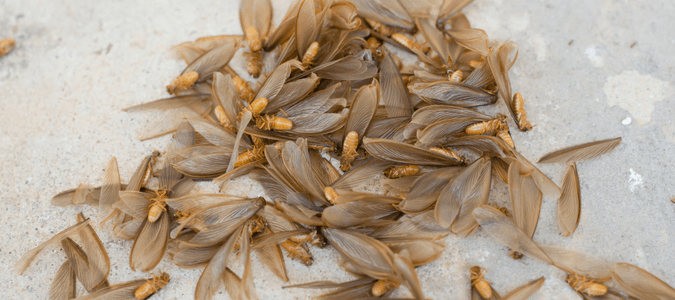
Being a homeowner has many benefits: having a space to call your own, a financial investment, and a place to create memories with your family. While the perks are numerous, we also recognize that there are a few headaches that present themselves as a homeowner. One of those annoyances is pests.
No matter which pest species decide to call your home theirs, homeowners often discover they have an infestation after noticing increased pests around their home, many times before it’s too late. Take flying termites, for example. Because termites live inside your home’s walls, many homeowners are unaware of their presence until they see winged pests flying inside or find shredded wings around doors and windows inside their homes. If you’re curious to know if you have an infestation, flying termites are a key warning sign indicating a problem.
Three major species of termites can potentially infest your home: dry wood, damp wood, and subterranean termites. Though each species thrives in different habitats, they all can find and make their nests near or inside their homes. Of these three termite types, subterranean termites (native or invasive Formosan species) are blamed for the most damage to living structures.
Flying termites belong to each species. But what exactly are they? Simply put, flying termites belong to one of three termite castes, or groups, within the termite colony. The flying termites belong to the alates caste; the other two are the worker and soldier termites. Of the three castes, only the alates can fly. They are also referred to as the reproductive caste. They are the only types of termites with wings and the only termites that are sexually developed to reproduce. As such, they mature into colony kings and queens.
Unmated termites are called pre-reproductives and typically possess wings before leaving the colony, remaining inside the nest for periods before leaving in search of new mates. However, when it’s warm enough to leave the nest, the alates termites emerge in large numbers, where they get their common name—swarmers. This process generally takes place each spring, although, in some areas, the swarming season can start as early as January and begin as late as May.
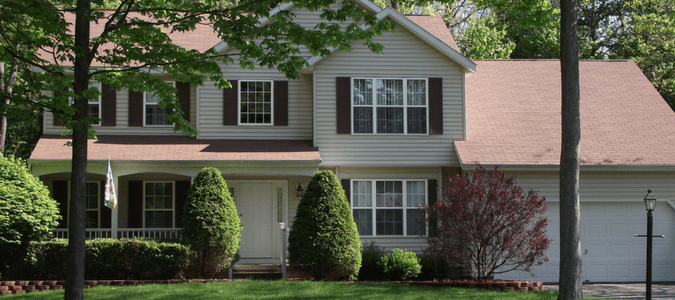
Flying Termites In My House: Why Do They Swarm?
While it might seem dangerous to leave their nest, flying termites must do so to mate. The biological reason for leaving their nest to mate is to ensure better mixing between colonies, which helps species remain stronger and better equipped to adapt to a changing environment and conditions successfully.
When it’s finally time to mate, both male and female swarmers leave the nest and travel short distances. Being weak fliers, termites rely on wind currents to help them travel, and even then, only a tiny percentage of those swarmers who leave the nest survive, as many fall prey to other predators or die from dehydration. The flying termites that make it, though, meet with other colonies of the same species who are also mating. Males and female flying termites pair off using pheromones, and if successful, the pair lands loses its wings, seeks cover and finally creates a small nest before mating. This is the start of a new colony.
The female, or soon-to-be queen termite, will only lay a few eggs initially, and she’ll only lay a few hundred eggs in the first year. While this might sound like a lot, she’ll continue to lay more eggs as she continues to grow. Once the eggs hatch and mature, they grow to be ¼ to ⅜ of an inch and have four wings. If you’ve ever asked yourself the question: What do baby termites look like?, the answer is that depending on the flying termite species they belong to, they can range from light to dark brown or black.
If a swarmer makes its way into your home, you’ll probably see it crawling more often than these creatures actually flying. When indoors, swarmers lose their wings relatively quickly and could be mistaken for an ant, especially because ant species swarm around the same time each year. The main difference is that termites lack the pinched-in waist that ants have.
Another sign you might have termites is when you notice dirt in strange locations around your house, such as around doorjambs and window frames. These termite souvenirs are the remains of tubes extending out from the wall and are the way swarmers emerge, looking for a new place to nest. The tubs are generally only about an inch across but can sometimes be up to a foot in length. If you see something resembling a mud dauber nest, it might be evidence of swarmer activity.
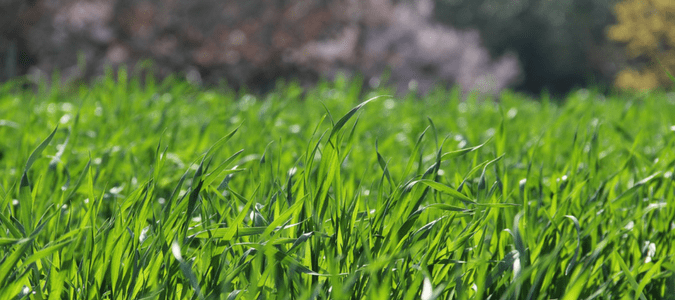
Where Do Flying Termites Come From?
As mentioned above, there are three types of termites, so where a termite comes from depends on its species. As their name suggests, subterranean termites come from underneath the ground, deep in the soil. And as a result, typically, these pests enter your home from its foundation. When seeking food, though, they prefer softwoods, but they have been known to invade just about any wood species as well. Just like subterranean termites, damp wood termites tend to stay close to the ground in the soil, but instead of softwoods, this species tends to choose moist, decaying wood, regardless of its location. Drywood termites are a bit different. Most often found in attics, this species requires little moisture in the wood that makes up its diet.
No matter their wood preference, termites enter your home for food, water, and shelter. These pesky pests create their nests inside your home, so when it comes time for the swarmers to mate, many leave their nests hoping to pair up but ultimately become trapped inside your home, looking for an exit. Furthermore, and like many other insects, flying termites are attracted to light. So it’s not uncommon for swarmers to become trapped inside while flying toward the light fixtures around your home.
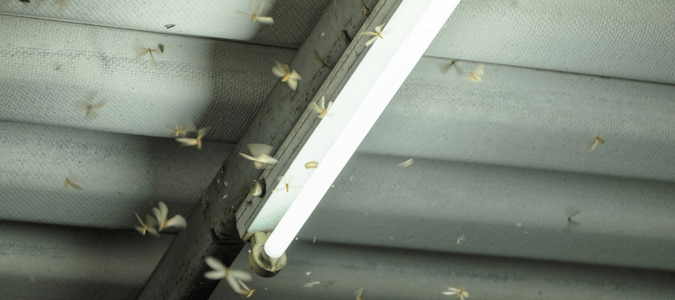
Why Are Flying Termites In My House? Other Reasons
Another reason termites might be flying around your home is its proximity to another termite colony. Because alates, or reproductive stage termites, leave their nests to find partners in another colony, some termites might be drawn to your home because another colony is located inside or underneath your home, on your lawn, or close by.
While we don’t want to ignite a sense of panic, spotting a few swarming termites inside your home is typically a solid indication of an active termite infestation. To properly check for evidence of flying termites, you’ll want to look around for fallen wings by doors or windows and damaged wood inside or around your home’s structure.
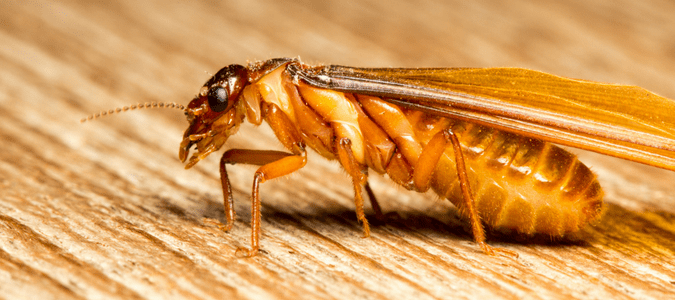
How To Get Rid Of Flying Termites In Your Home
Because of their ability to cause extreme damage, flying termites and the other members of their colony are notorious as the most expensive pests you’ll have to deal with as a homeowner. So if you notice any of the possible infestation signs mentioned above, you’ll want to begin addressing the situation as quickly as possible.
Termites are both difficult to find and almost impossible to completely eradicate alone. As such, government agencies recommended hiring a termite control specialist to quickly and effectively address the problem before the damage becomes extensive. Our ABC Home & Commercial Services team is equipped to do just that.
While controlling termites is best left to the professionals, there are a few tactics homeowners can try to prevent termites from entering their homes,s to begin with. The first step is removing termites’ access to food (usually wood), moisture, and shelter. Some homeowners choose to install bait stations around their property to neutralize these pests, but without a good understanding of termite activity, it can be difficult to know where to put them.
Most termite problems can be most effectively tackled during the construction phases of a home or via mechanical alterations once a home is built. For starters, when building a new structure, position your home’s base so the soil slopes away from the structure in every direction. In the same regard, you’ll want to remove any planter boxes or soil-filled porches you plan to build. Any structure that allows termites to enter it from the soil beneath offers an accessible entryway into your home. Similarly, plant any shrubs or foliage as far away from your home as possible, as the humidity created by the plants increases your home’s appeal and affects your ability to inspect the foundation line of your home correctly.
Finally, treat any outdoor wooden structures with preservatives if they are exposed to rain, ensure all foundation openings for plumbing or service utilities are well-sealed and caulked, remove any debris or spare materials that are littered around your lawn, and be sure to clean out your gutters regularly.
ABC Can Help When Flying Termites Swarm
As we mentioned above, owning a home can be a rewarding experience. So don’t let flying termites and their colonies be the cause of one big, expensive headache. Instead, let the professionals take care of any signs of termite infestations you might see. Our pest control exterminators will arrive at your home and thoroughly inspect your property to assess any damage properly, look for entry points around your structure, and discuss a treatment plan that is effective and customized to meet your needs.